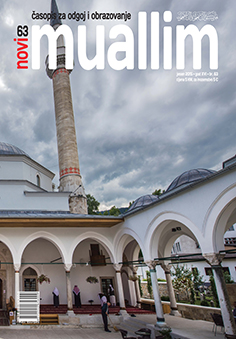LINGVISTIČKI ASPEKTI DOVE U KUR’ANU
DOI:
https://doi.org/10.26340/muallim.v16i63.112Ključne riječi:
Dova, Kur’an, molidbene rečenice, lingvistički aspekti dove, sintaksa molidbenih rečenicaSažetak
UDK 28-23:81’374.42
28-24-254
Dova ima veliki značaj u životu muslimana. Dovom se čovjek obraća Uzvišenom Allahu radi postizanja Njegove milosti i oprosta grijeha, stjecanja određenih ovosvjetskih blagodati i isticanja Allahove jednote, čime se iskazuje pokornost Stvoritelju, odaje posebna čast i ljubav prema Uzvišenom Allahu i ističe oslanjanje isključivo na Allaha. Zbog toga je dova, naročito kur’anskoga iskaza, često bila predmet istraživanja i tumačenja islamskih učenjaka sa različitih aspekata uključujući i njenu lingvističku dimenziju. Budući da je ovaj aspekt dove u Kur’anu u našoj literaturi rijetko tretiran ili skoro uopće nije, ovaj rad ima za cilj istraživanje i utvrđivanje sintaksičkih karakteristika kur’anskoga iskaza kojim se u formi dove (du‘ā’) kao molbe obraća Stvoritelju radi postizanja raznovrsnih blagodati ili zaštite od nesreće i ružnih stvari na Ovom i na Budućem svijetu. Rečenice kojima se u Kur’anu iskazuje dova označavaju se kao ğumal du‘ā’iyya (molidbene rečenice), a izriču se u formi imperativnih, prohibitivnih i interogativnih rečenica koje predstavljaju vrstu zahtjevnih performativnih rečenica (ğumal inšā’iyya ṭalabiyya), te u formi izjavnih (ğumal ẖabariyya) koje u tom slučaju izražavaju značenje performativnih iskaza. U svim ovim rečenicama govornik se u metaforičkom značenju imperativa (amr) ili prohibitiva (nahy) ponizno i skrušeno obraća Stvoritelju moleći Ga da udovolji njegovoj molbi. Sve vrste navedenih molidbenih rečenica, osim što izražavaju duboko značenje istovremeno predstavljaju i posebnu vrstu stilističkih iskaza koji se odlikuju raznovrsnim stilističkim osobinama.
Downloads
Objavljeno
How to Cite
Broj časopisa
Rubrika
License
Naknada:
a. Časopis ne naplaćuje naknadu za obradu članaka (APC) i naknadu za podnošenje članaka.
Autori koji objavljuju u ovom časopisu pristaju na sljedeće uvijete:
- Autori zadržavaju autorska prava i pružaju časopisu pravo prvog objavljivanja, pri čemu će rad jednu godinu po objavljivanju biti podložan licenci Creative Commons imenovanje koja omogućuje drugima da dijele rad uz uvijet navođenja autorstva i izvornog objavljivanja u ovom časopisu.
- Autori mogu izraditi zasebne, ugovorne aranžmane za ne-ekskluzivnu distribuciju rada objavljenog u časopisu (npr. postavljanje u institucionalni repozitorij ili objavljivanje u knjizi), uz navođenje da je rad izvorno objavljen u ovom časopisu.


